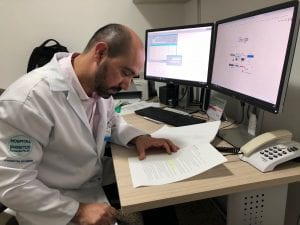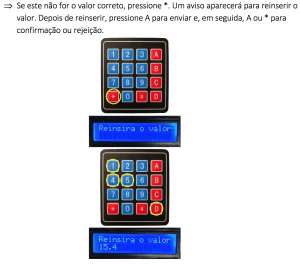The body of the device is still in the manufacturing process down the road at the factory (fingers crossed it is ready tomorrow!). In the meantime, I have been editing code and building a user manual that explains how to use the device with photos, explanations, and instructions. Each change in code usually adds a new section or new bullet point to the user manual, which I confirm with Dr. Wilson for clarity and grammar. I then make the suggested edits and realize a new line of code should be added. The cycle goes: edit code, fix user manual, confirm changes with Dr. Wilson, fix user manual, repeat.
Certain changes made to the operating system were necessary, like including a restart button and a rewinding of the motor. Other changes allow for the operating system to be more versatile, like changing the goal volume. When receiving the radioactive material, a patient will receive 1mL of fluid that is a mixture of the required amount of radioactive material plus the necessary amount of sodium chloride to complete 1mL. The Nuclear Medicine department almost always uses 1mL as their goal volume but the device allowing for this to be an adjustable value opens the possibility of use in different departments. So, I added in a few more lines, tested it out, and included this feature in the user manual.
Six weeks after creating the first Arduino file for this device, it is safe to say I know its operation system inside and out. I can mindlessly navigate through the prompts, input values, and restart the system. But when building the user manual, I put myself in the shoes of someone who has never used this device before. I tried to think about what I discovered on my own and how I can explain that with text and pictures. For example, if buttons are pressed during a summary screen, it will make your next value zero, which I found this out when I impatiently moved through the prompts. “Don’t press any buttons at this time,” I write in the user manual when introducing summary screens.
I began creating the user manual with a thought map in English, and then I began typing more specifically in Portuguese. Sometimes my Portuguese instructions require only a small grammar or vocabulary change and Dr. Wilson will write a note above the text. Other times, my Portuguese instructions are so bad that Dr. Wilson cannot understand what I’m even trying to say. When this is the case, we talk through the sentence, I try to give relevant example, or I type it into Google Translate as informally as possible. Dr. Wilson will then write out his version of the instruction in the margins while I nod along, realizing that his version of the instruction is much clearer than mine.
It is possible the user manual is too specific and has too much content. At this point, I don’t want to assume the user knows something that they in fact don’t. When the instruction says press A, I include a little photo of the keypad with the A button circled in yellow. But if the booklet is too long, the user may disregard it and attempt to fend for themselves. I don’t blame them; we’ve all done it. So, after building up a very specific user manual, I will work with Dr. Wilson to cut it down. But in the meantime, it’s more of editing code, fixing the user manual, confirming changes with Dr. Wilson on repeat.


